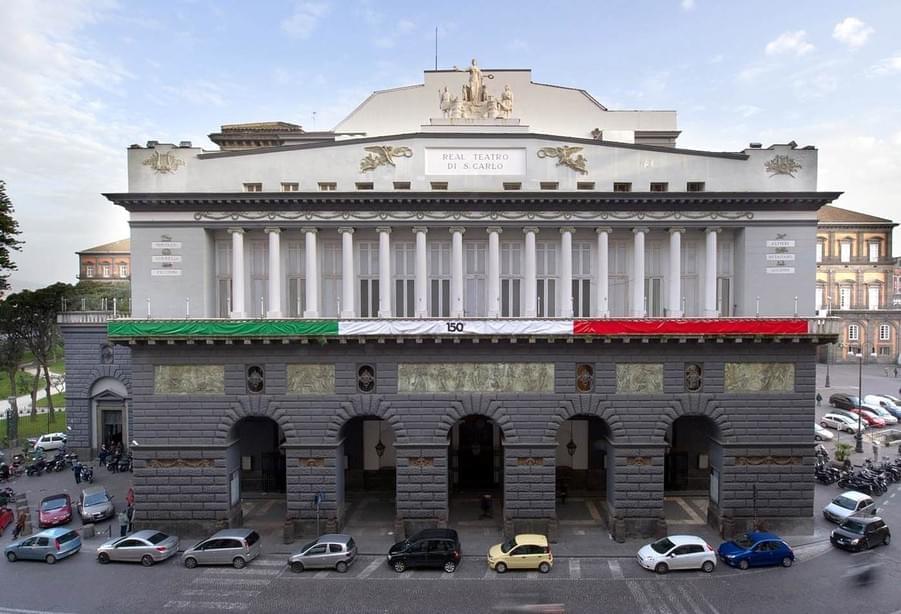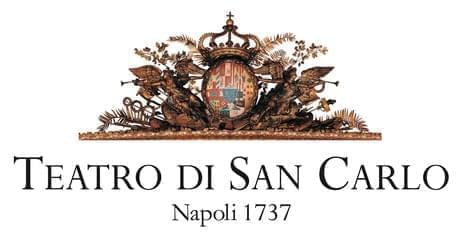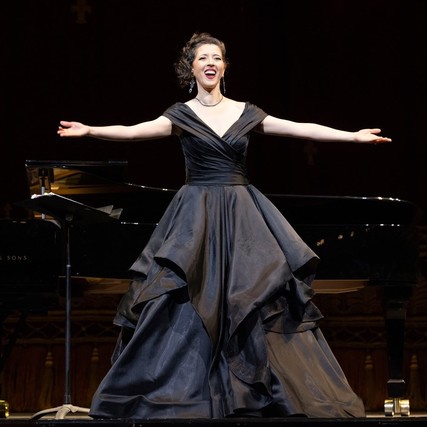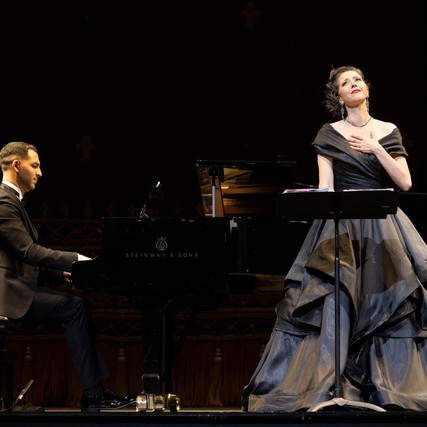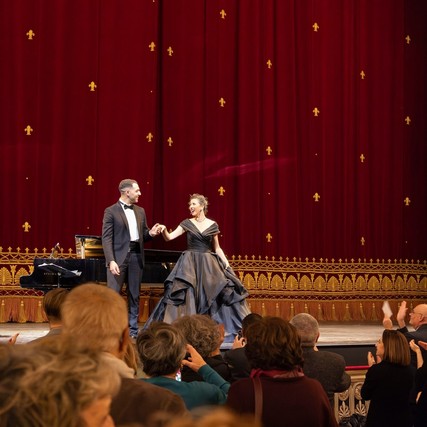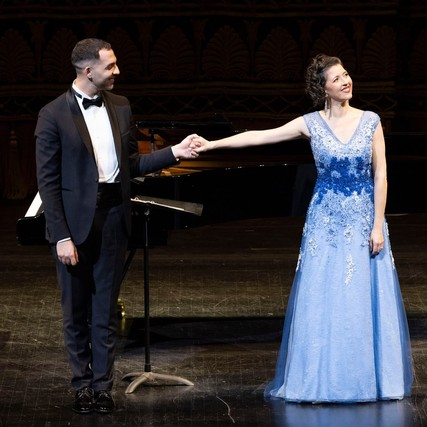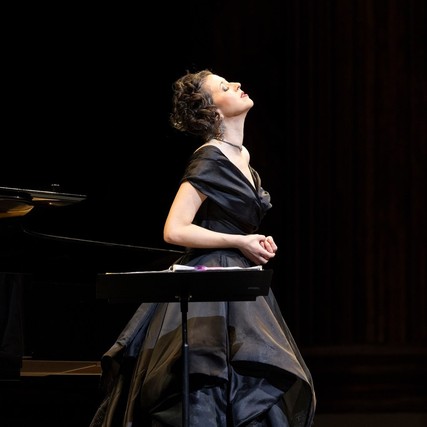Recital
Soloists
| Soprano | Lisette Oropesa | |
| Piano | Alessandro Praticò |
About
Lisette returns to the Teatro di San Carlo in Napoli to give a recital that highlights Italian and Spanish repertoire.
Program
Maurice Ravel
Chants populaires, “Chanson espagnole”
Vocalise-étude en forme de habanera
Léo Delibes
Bolero “Les filles de Cadix”
Jules Massenet
Chanson andalouse
Sevillana “A Séville, belles señoras”
Isaac Albéniz (Piano)
“Sevilla”, Suite española
Georges Bizet
“Oeuvre ton cœur”
“Adieux de l’hôtesse arabe”
Gioachino Rossini
Soirées musicales, “L’invito”
Saverio Mercadante
“La stella”
“La primavera”
Franz Liszt (Piano)
Sonnet 104 by Petrarca - Années de pèlerinage
Giuseppe Verdi
“È la vita un mar d’affanni”
“Stornello”
“Chi i bei di m’adduce ancora”
“Perduta ho la pace”
Les vêpres siciliennes, “Merci, jeunes amies”
BIS
Gioachino Rossini
La Danza
Ruperto Chapí
Carceleras - Zarzuela de Las Hijas del Zebedeo
Eduardo Di Capua
I' te vurria vasa
Giuseppe Verdi
Amami Alfredi - La traviata

❄️ 2025 - Winter Newsletter
Welcome to my Winter 2025 Newsletter!
Reviews
Naples, Oropesa/Praticò concert, 01/09/2025
Si apprezzano nell’interpretazione di Lisette Oropesa la cavata e l’afflato lirico, l’abbandono alla elegante cantabilità delle melodie di Mercadante, l’irrobustimento del peso specifico della sua vocalità, che in queste pagine anticipa, in un recital dalla coerente e ben ponderata scelta dei brani, quella appropriata alle quattro successive romanze da camera di Giuseppe Verdi, È la vita un mar d’affanni, Stornello, Chi i bei dì m’adduce ancora, Perduta ho la pace. La lettura di queste quattro pagine è un microcosmo di stati d’animo, di fraseggio ricercato, un esempio di versatilità. Qui Lisette Oropesa riesce a trovare la “tinta” più appropriata per ciascuna romanza, la giusta accentazione, la migliore prosodia per ogni parola.One appreciates in Lisette Oropesa's interpretation the flourish and lyrical inspiration, the surrender to the elegant singability of Mercadante's melodies, the strengthening of the specific weight of her vocals, which in these pages anticipates, in a recital from the coherent and well-considered selection of pieces, that appropriate for the four subsequent chamber romances by Giuseppe Verdi, Life is a sea of troubles, Stornello, Who brings me the good days again, I lost my peace. The reading of these four pages is a microcosm of emotional states, of sought-after phrasing, an example of versatility. Here Lisette Oropesa manages to find the most suitable "shade" for each romance, the right accentuation, the best prosody for each word.— Luigi Raso • L'ape musicale
Napoli - Teatro di San Carlo: Lisette Oropesa
Dopo avere riservato applausi calorosi durante la serata, al termine il pubblico si è scatenato in ovazioni e acclamazioni interminabili, da qui una serie di bis: dalla Danza rossiniana di cui abbiamo detto a un’aria dalla Zarzuela Las Hijas del Zebedeo di Ruperto Chapí, terminando con “I’ te vurria vasa’”, omaggio a Napoli commovente per lo scrupolo esecutivo e l’intensa espressività messa nei versi, tra l’altro con ottima dizione. Bellissima chiusa per una serata da inserire fra le migliori di questa stagione sancarliana.After holding back enthusiastic applause throughout the evening, at the end, the audience erupted into never-ending ovations and acclamations, leading to a series of encores: from the Rossinian Dance we mentioned, to an aria from Ruperto Chapí's Zarzuela Las Hijas del Zebedeo, and concluding with "I te vurria vasa", a moving tribute to Naples characterized by meticulous execution and intense emotional expression in the lyrics, also delivered with excellent diction. A beautiful ending to an evening that ranks among the best of this San Carlo season.— Bruno Tredicine • Opera Click
Napoli, Teatro San Carlo – Recital di Lisette Oropesa
Fino poi a chiudere in gran trionfo, fra i lunghi e caldissimi applausi, con una raffica di quattro bis mozzafiato: la qui auspicata e vertiginosa al limite dell’eseguibile Danza dalle Soirées musicales di Rossini, l’aria parimenti velocissima Carceleras dalla zarzuela Las hijas del Zebedeo del compositore spagnolo di fine Ottocento Ruperto Chapí Lorente, un cult della canzone classica napoletana qual è I’ te vorria vasà di Eduardo Di Capua pubblicata nell’anno 1900 – con sorprendente padronanza nella dizione del testo – e, accontentando la richiesta espressa a gran voce da uno spettatore di barcaccia, l’Amami Alfredo estratto dalla Traviata di Verdi gestualizzandone il peso dell’”Addio” a braccia curve verso l’alto come a calcare simpaticamente l’ormai opportuno distacco al culmine di un vero e proprio tour vocal de force.Leading up to a grand finale, amid long and extremely warm applause, with a breathtaking flurry of four encores: the highly anticipated and vertiginously challenging Dance from Rossini's Soirées musicales, the equally rapid Carceleras from the zarzuela Las hijas del Zebedeo by the late-nineteenth-century Spanish composer Ruperto Chapí Lorente, a classic of Neapolitan song like I’ te vorria vasà by Eduardo Di Capua, published in the year 1900 - with surprising mastery in the diction of the text - and, fulfilling a loudly expressed request from a spectator in the audience, Amami Alfredo from Verdi's Traviata, performing the weight of the "Farewell" with arms curved upwards as if to humorously underscore the now appropriate detachment at the peak of a true vocal tour de force.— Paola De Simone • Conessi all'Opera
Il virtuosismo di Lisette Oropesa
Più sobria ma marcata la bellissima aria da Soirées musicales, “L’invito” di Rossini, il discorso musicale scivola come fossero un unico strumento. In “La stella” e “La primavera” di Mercadante la forma sembra trasformata in un incantato virtuosismo tra sentimenti e voce, confidenziale, a tu per tu, come se fosse la prima volta che lo affronta. Mai un calo di tensione. Praticò dosa il volume distillando una serie di pianissimo, come sussurri che sfidano l'udito dei più nell’introduzione di “La Primavera”, magica. Qui il soprano era su timbri ideali, corposi, bruniti, come se Mercadante restituisse tutta l'espressività della voce della Oropesa, la sua genialità e bellezza. Conclude “Merci, jeunes amies” da Les vêpres Siciliennes di Verdi, preceduto da “È la vita un mar d’affanni”, “Stornello”, “Chi i bei dì m’adduce ancora”, “Perduta ho la pace” e si scardina ogni convenzione di interpretazione, di scansione ripetuta, dove scorre libero il fraseggio creando forme e prospettive mai osate prima.The beautiful aria from Soirées musicales, “L'invito” by Rossini is more restrained yet distinctive, the musical discourse flows as though it were a single instrument. In Mercadante's “La stella” and “La primavera”, the form seems transformed into an enchanted virtuosity between feelings and voice, like a confidential, face-to-face conversation, as if it was the first time it's being addressed. The tension never drops. Praticò controls the volume, distilling a series of whispered pianissimos that challenge the hearing in the introduction to “La Primavera”, magical. Here the soprano was on ideal tones, full-bodied, tanned, as if Mercadante returned all the expressiveness of Oropesa's voice, her genius, and beauty. It concludes with “Merci, jeunes amies” from Verdi's Les vêpres Siciliennes, preceded by “È la vita un mar d’affanni”, “Stornello”, “Chi i bei dì m’adduce ancora”, “Perduta ho la pace” and shatters all conventions of interpretation, of repeated scanning, where the phrasing flows freely creating forms and perspectives never dared before.— Salvatore Morra • Giornale della Musica

